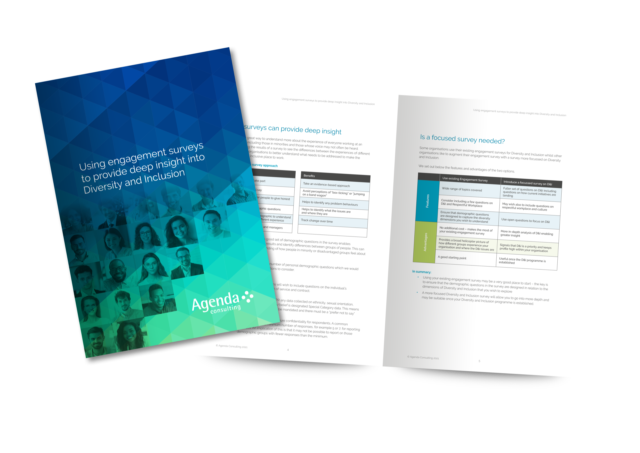
Insights
Helping not-for-profit organisations develop and sustain
the highest levels of employee and volunteer engagement

Insights

Many organisations are taking a proactive approach to creating an inclusive place to work. However, employees’ experiences of working for your organisation will likely differ.
So how can we understand these differences and take an evidence-based approach to creating an inclusive workplace?
Employee surveys can be a great tool to help understand the different experiences of staff and drive inclusion in your organisation.
Here are 5 ways to use employee surveys to drive your understanding of diversity and inclusion.
We’ve been gathering data on D&I-focused questions since 2020. In this time, we’ve found that some questions show a larger difference between the best-performing 25% of organisations and the lowest-performing 25% (this is called the Interquartile Range: IQR).
Questions that show not much difference between organisations’ results have a low IQR. This means that for these questions, many organisations are performing similarly and they are arguably less insightful.
Questions that have a large difference between results have a strong IQR. When a question has a strong IQR, it shows us that it is a discerning question. These questions are great at helping to understand if your organisation is performing well or less well compared to other organisations on this topic. Including them in your survey will provide you with deeper insight.
From the chart below, you can see that the most discerning questions are:
“My organisation internally and externally communicates information about its diversity goals”
“The Leadership group demonstrates their commitment to Equality, Diversity and Inclusion”
“People here are treated equally irrespective of ethnicity, gender, disability, age, sexual orientation or religion”.
We encourage our clients to use demographic questions that include:
Putting thought into the questions and options you include is important, because it determines how you’ll be able to disaggregate the data later.
When you carve up the survey results using the demographic information, it can reveal key details about how your employees’ experience varies. It means every question can give you D&I insight. Knowing that, you’ll be better placed to make your organisation a more inclusive place to work.
The screenshot below is from an engagement survey dashboard in our platform, Reflections. You can see that for this organisation, there’s significant variation in employee satisfaction by sexual orientation.
Understanding how results vary for different demographic groups across all topics in your survey means that you can implement targeted interventions to support different groups.
Intersectionality is the way that personal demographics combine and overlap, creating a unique personal profile that influences an employee’s experience.
You can leverage your demographic questions to dig into the experiences of, for example:
This analysis is powerful to capture variation you might otherwise have missed.
Using intersectional analysis, we’ve recently helped organisations to:

It is important that senior management demonstrates they have heard the key messages, and positive action needs to be catalysed at all levels of the organisation.
We encourage you to share your results widely, and especially with interest groups such as staff networks and affinity groups.
As much as possible, give these groups access to the data – so that they are empowered to understand their colleagues’ diverse experiences, to include them in change processes, and to take some of the work off your shoulders!
Our platform guarantees confidentiality, so you can feel confident in cascading access to survey results.
We know that survey results can lead to difficult conversations, but these are crucial to moving forward.
Organisations like Power to Change are showing commitment to DEI by having these difficult conversations and not avoiding the topic just because it can be tricky. Power to Change use their annual employee engagement survey to gather feedback on DEI. They make feedback-based changes to improve DEI within their organisation.
A regular survey rhythm will help you stay on top of the progress your organisation is making on its commitments, and to change course when necessary.

Your rhythm might be centred around a full annual or biennial employee survey, but organisations are increasingly using pulse surveys to monitor progress or to take a deeper look at topics like diversity and inclusion.
If you’re not sure which is right for you, our white paper Using Engagement Surveys to Provide Deep Insight into Diversity and Inclusion might point you in the right direction.
If you have any questions about understanding Diversity and Inclusion in your organisation, we’d be happy to discuss this with you – get in touch
5 Linford Forum
Rockingham Drive
Milton Keynes
MK14 6LY
UK
Company No: 4509427
